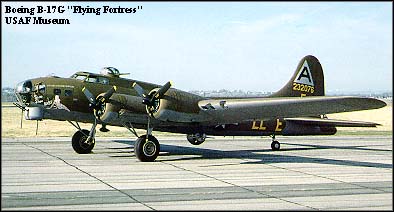The Flying Fortress is one of the most famous airplanes ever built. The B-17 prototype first flew on the 28th of July, 1935. Few B-17s were in service on the 7th of December, 1941 but production quickly accelerated. The aircraft served in every WW II combat zone, but is best known for daylight strategic bombing of German industrial targets. Production ended in May 1945 and the total built then was 12,726. In March of 1944 this B-17G was assigned to the 91st Bomb Group - "The Ragged Irregulars" - and based at Bassingbourn, England. There it was named Shoo Shoo Baby by its crew, after a popular song. It was later renamed "Shoo Shoo Shoo Baby" after another pilot replaced the original aircraft commander. It flew 24 combat missions in WW II, received flak damage seven times. Its first mission (Frankfurt, Germany) was on the 24th of March, 1944 and its last mission (Posen, Poland) was on the 29th of May, 1944, when engine problems forced a landing in neutral Sweden where the airplane and crew were interned. In 1968, Shoo Shoo Shoo Baby was found abandoned in France; the French Government presented it to the USAF In July 1978, the 512nd Military Airlift Wing moved it to Dover Air Force Base, Delaware, for restoration by the volunteers of the 512nd Antique Restoration Group. The massive 10 year job of restoration to flying condition was completed in 1988 and the aircraft was flown to the Museum in October, 1988. The serial number of the aircraft in the photo above is 42-32076.
Specifications Boeing B-17G "Flying Fortress"
Wingspan 103' 10"
Length 74' 4"
Height 19' 1"
Weight (combat) 55,000 lbs.
Powerplants Four Wright "Cyclone" R-182s of 1,200 hp. ca.
Defensive Armament Thirteen .50 cal. machine guns with normal bomb load of 6,000 lbs.
Maximum Speed 300 mph
Cruising Speed 170 mph
Range 1,850
Service Ceiling 35,000 ft.
Cost to produce $276,000
![]()
